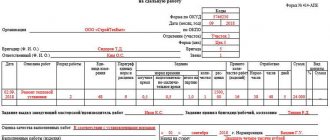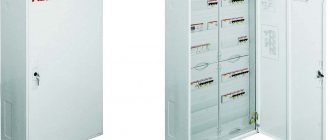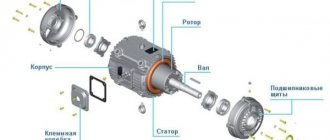Categories of electrical energy consumers
The power supply system is a set of devices used to receive, transmit and distribute electrical energy. It is intended to supply consumers of electricity to enterprises, which include electric motors of various production mechanisms and units, electric furnaces, installations for electric welding, lighting and electrolysis installations, etc.
The power supply system of industrial enterprises must ensure uninterrupted supply of electricity to consumers, reliability, high quality of electricity, and the safety of electrical installations for the life and health of operating personnel.
There are electricity consumers who do not allow interruptions in power supply. In particular, these include chemical and metallurgical enterprises. Here, a power outage can lead to the failure of expensive equipment; in chemical plants it can cause an explosion. In other cases, a break in the power supply entails a danger to the lives of operating personnel (for example, stopping the ventilation of mine workings due to a lack of electricity can lead to gas poisoning of people).
There may be other consequences caused by a power outage. Interruptions in power supply are especially dangerous for industries with complex technological processes, when equipment shutdown is accompanied by a significant undersupply of important products to consumers.
Modern large cities, with their complex transport and housing systems, are also very sensitive to interruptions in energy supply. As an example, it is enough to cite the case of a power outage in New York that took place in the summer of 1965. As a result, the complex urban economy was put out of action for several days (experts call this accident the “catastrophe of the century”).
Other consumers are not as sensitive to power outages. For them, a power outage does not cause particularly serious consequences.
Taking this into account, the rules for the construction of electrical installations (PUE) provide for three categories of electricity consumers according to the conditions for ensuring uninterrupted power supply:
1st category - consumers of electricity, disruption of the power supply to which may entail danger to human life, significant damage to the national economy, damage to equipment, mass defects of products, disruption of a complex technological process, disruption of the functions of particularly important elements of the municipal economy;
2nd category - electricity consumers whose power supply interruption is associated with a massive undersupply of products, downtime of workers, machinery, technological equipment and industrial transport, disruption of the normal life of a significant number of people;
3rd category - all other consumers of electricity that do not fit the definitions of consumers of the 1st and 2nd categories (for example, consumers of non-serial production workshops, auxiliary workshops, small villages, etc.).
Electricity consumers of the 1st category must be provided with electricity from two independent power sources; interruption of their power supply can be allowed only for the period of automatic activation of the backup power supply.
When the power of category 1 electricity consumers is low, mobile power stations, batteries, and low-voltage jumpers from the nearest point with independent power supply with automatic transfer switching (ATS) can be used as a second power source.
For consumers of electricity of the 2nd category, interruptions in power supply are allowed for the time necessary to turn on backup power by the actions of duty personnel or a mobile operational team.
For consumers of electricity of the 3rd category, interruptions in power supply are allowed for the time necessary to repair or replace a damaged element of the power supply system, but for a period of no more than one day.
The power supply system is a set of devices used to receive, transmit and distribute electrical energy. It is intended to supply consumers of electricity to enterprises, which include electric motors of various production mechanisms and units, electric furnaces, installations for electric welding, lighting and electrolysis installations, etc.
The power supply system of industrial enterprises must ensure uninterrupted supply of electricity to consumers, reliability, high quality of electricity, and the safety of electrical installations for the life and health of operating personnel.
There are electricity consumers who do not allow interruptions in power supply. In particular, these include chemical and metallurgical enterprises. Here, a power outage can lead to the failure of expensive equipment; in chemical plants it can cause an explosion. In other cases, a break in the power supply entails a danger to the lives of operating personnel (for example, stopping the ventilation of mine workings due to a lack of electricity can lead to gas poisoning of people).
There may be other consequences caused by a power outage. Interruptions in power supply are especially dangerous for industries with complex technological processes, when equipment shutdown is accompanied by a significant undersupply of important products to consumers.
Modern large cities, with their complex transport and housing systems, are also very sensitive to interruptions in energy supply. As an example, it is enough to cite the case of a power outage in New York that took place in the summer of 1965. As a result, the complex urban economy was put out of action for several days (experts call this accident the “catastrophe of the century”).
Other consumers are not as sensitive to power outages. For them, a power outage does not cause particularly serious consequences.
Taking this into account, the rules for the construction of electrical installations (PUE) provide for three categories of electricity consumers according to the conditions for ensuring uninterrupted power supply:
1st category - consumers of electricity, disruption of the power supply to which may entail danger to human life, significant damage to the national economy, damage to equipment, mass defects of products, disruption of a complex technological process, disruption of the functions of particularly important elements of the municipal economy;
2nd category - electricity consumers whose power supply interruption is associated with a massive undersupply of products, downtime of workers, machinery, technological equipment and industrial transport, disruption of the normal life of a significant number of people;
3rd category - all other consumers of electricity that do not fit the definitions of consumers of the 1st and 2nd categories (for example, consumers of non-serial production workshops, auxiliary workshops, small villages, etc.).
Electricity consumers of the 1st category must be provided with electricity from two independent power sources; interruption of their power supply can be allowed only for the period of automatic activation of the backup power supply.
When the power of category 1 electricity consumers is low, mobile power stations, batteries, and low-voltage jumpers from the nearest point with independent power supply with automatic transfer switching (ATS) can be used as a second power source.
For consumers of electricity of the 2nd category, interruptions in power supply are allowed for the time necessary to turn on backup power by the actions of duty personnel or a mobile operational team.
For consumers of electricity of the 3rd category, interruptions in power supply are allowed for the time necessary to repair or replace a damaged element of the power supply system, but for a period of no more than one day.
-The maximum levels of unregulated prices for electrical energy (power) (hereinafter referred to as the maximum levels of unregulated prices) for the corresponding billing period are calculated by the supplier of last resort according to the following price categories: the first price category - for...
Expand
— The maximum levels of unregulated prices for electrical energy (power) (hereinafter referred to as the maximum levels of unregulated prices) for the corresponding billing period are calculated by the supplier of last resort according to the following price categories: the first price category - for volumes of purchase of electrical energy (power), which are taken into account in general for billing period; the second price category is for volumes of purchase of electrical energy (power), which are accounted for by zones of the day of the billing period; the third price category - for volumes of purchase of electrical energy (power), for which hourly accounting is carried out, but hourly planning is not carried out, and the cost of services for the transmission of electrical energy is determined according to the tariff for services for the transmission of electrical energy in single-rate terms; fourth price category - for volumes of purchase of electrical energy (power), for which hourly accounting is carried out, but hourly planning is not carried out, and the cost of services for the transmission of electrical energy is determined according to the tariff for services for the transmission of electrical energy in two-rate terms; fifth price category - for volumes of purchase of electrical energy (power), for which hourly planning and accounting are carried out during the billing period, and the cost of services for the transmission of electrical energy is determined according to the tariff for services for the transmission of electrical energy in single-rate terms; the sixth price category is for volumes of purchase of electrical energy (power), for which hourly planning and accounting are carried out during the billing period, and the cost of services for the transmission of electrical energy is determined according to the tariff for services for the transmission of electrical energy in two-part terms. The maximum levels of unregulated prices are differentiated by voltage levels in accordance with the differentiation used in determining the maximum levels of tariffs (tariff rates) for electric energy transmission services, and the maximum levels of unregulated prices are differentiated by groups (subgroups) of consumers. Differentiation of maximum levels of unregulated prices for electrical energy (power) by high first voltage (VN1) applies only to the fourth and sixth price categories.
Decree of the Government of the Russian Federation dated 04.05.2012 No. 442 p.86
General requirements
1.2.11. When designing power supply systems and reconstructing electrical installations, the following issues should be considered:
- prospects for the development of energy systems and power supply systems, taking into account the rational combination of newly constructed electrical networks with existing and newly constructed networks of other voltage classes;
- ensuring an integrated centralized power supply to all consumers of electrical energy located within the coverage area of electrical networks, regardless of their affiliation;
- limitation of short-circuit currents to limit levels determined for the future;
- reduction of electrical energy losses;
- compliance of decisions made with environmental protection conditions.
At the same time, external and internal power supplies should be considered in combination, taking into account the capabilities and economic feasibility of technological redundancy.
When addressing redundancy issues, one should take into account the overload capacity of electrical installation elements, as well as the availability of reserves in process equipment.
1.2.12. When addressing issues of development of power supply systems, repair, emergency and post-emergency modes should be taken into account.
1.2.13. When choosing independent, mutually redundant power sources that are objects of the power system, one should take into account the likelihood of a simultaneous dependent short-term decrease or complete disappearance of voltage during the operation of relay protection and automation in the event of damage in the electrical part of the power system, as well as a simultaneous long-term loss of voltage on these power sources during severe system failures. accidents.
1.2.14. Requirements 1.2.11-1.2.13 must be taken into account at all intermediate stages of development of energy systems and power supply systems.
1.2.15. The design of electrical networks should be carried out taking into account the type of their service (permanent duty, duty at home, mobile teams, etc.).
1.2.16. The operation of electrical networks with a voltage of 2-35 kV can be provided either with an isolated neutral or with a neutral grounded through an arc suppression reactor or resistor.
Compensation for capacitive ground fault current should be applied for the values of this current in normal modes:
- in networks with a voltage of 3-20 kV, having reinforced concrete and metal supports on overhead power lines, and in all networks with a voltage of 35 kV - more than 10 A;
- in networks that do not have reinforced concrete and metal supports on overhead power lines: more than 30 A at a voltage of 3-6 kV;
- more than 20 A at a voltage of 10 kV;
- more than 15 A at a voltage of 15-20 kV;
in generator voltage circuits of 6-20 kV generator-transformer blocks - more than 5A.
For ground fault currents of more than 50 A, it is recommended to use at least two grounding reactors.
The operation of electrical networks with a voltage of 110 kV can be provided with both a solidly grounded and an effectively grounded neutral.
Electrical networks with voltages of 220 kV and higher must operate only with a solidly grounded neutral.









